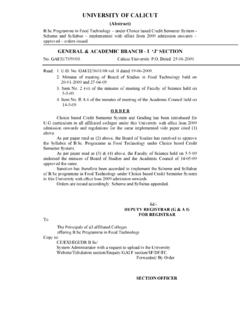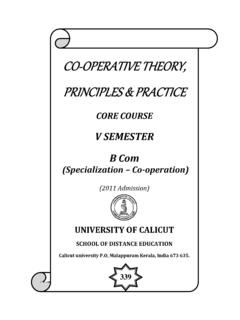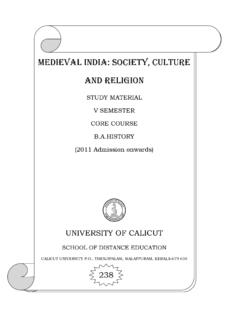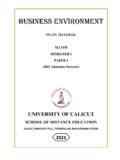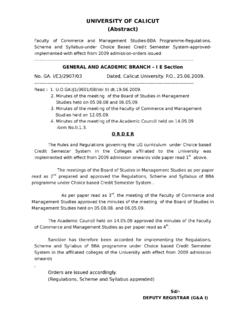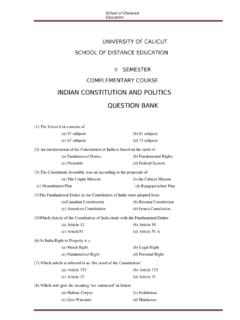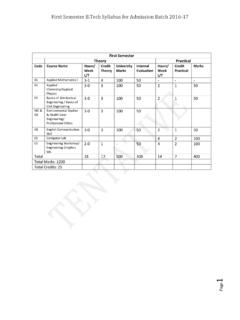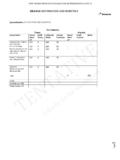Transcription of GENERAL & ACADEMIC BRANCH-IV ‘E’ SECTION O …
1 UNIVERSITY OF CALICUT. (Abstract). Programme Core Course computer Application syllabus approved implemented with effect from 2010 ACADEMIC year onwards - Orders issued. GENERAL & ACADEMIC BRANCH-IV E' SECTION . No. GA IV/E3/4030/2010 Dated, Calicut University PO, Read: 1. I/E3/6792/04 dated 2. Item of the minutes of the meeting of Board of Studies in Commerce UG held on ORDER. The Regulation, Scheme and syllabus of programme under Choice based Credit Semester System in the affiliated colleges of the University was implemented with effect from 2009 admission onwards vide read as 1st. As per paper read as 2nd, the Board of Studies prepared the syllabi for the core course computer Application.
2 Considering the urgency of the matter the Vice-Chancellor exercising the powers of ACADEMIC Council has approved the syllabus of the core course computer Application of program, subject to ratification by ACADEMIC Council. Sanction has therefore been accorded for implementing the syllabi of the core course computer Application of programme with effect from 2010 ACADEMIC year onwards subject to ratification of ACADEMIC Council. Orders are issued accordingly. ( syllabus appended). Sd/- DEPUTY REGISTRAR(G&A. IV). For REGISTRAR. To The Principals of all colleges offering Copy to: CE/EX SECTION /EGI SECTION /DR-AR Forwarded/By Order System Administrator (with a request to upload in the University website) GAI F' SECTION /.
3 GAIV J' SECTION /SF/DF/FC. SECTION OFFICER. /home/digital/ UNIVERSITY OF CALICUT. (CCSS)2009. CORE COURSES IN THE AREA OF SPECIALISATION. D. computer APPLICATIONS. BC5B10 FUNDAMENTALS OF COMPUTERS. Lecture Hours 5 Credits 4. Objective: To enable the students to acquire basic knowledge in the fundamentals of computers and its applications in the various areas of business. Module 1: Exploring the computer (10 Hrs). computer definition - computer users - computer for individual users - computer for organizations - computer in society Components of computer - input unit - output unit - storage unit CPU- ALU - control unit - registers - computer hardware System software - Application software.
4 Module II computer systems (10 Hrs). computer systems - Types of computer systems- Micro, Mini, Mainframe and Super Computers - Analog, Digital and Hybrid Computers - Business and Scientific computer systems - First, second, third and fourth generation Computers - Laptop and notebook Computers Module III Data Processing (18 Hrs). computer data - Information Data Processing - Data Storage and Data retrieval capabilities storage devices - primary memory - RAM, ROM, PROM, EPROM, cache memory - secondary memory - magnetic tape, hard disk, Compact disks - Importance of computers in business - computer applications in various areas of business- computer related jobs in business.
5 Module IV Peripheral devices (10 Hrs). Input devices keyboard, mouse, scanner - output devices monitor - VDU, LCD, CRT - printers - Commonly used printers, High-quality printers, Thermal-wax printers, Dye- sublimation printers, Plotters. Module V Operating Systems (12 Hrs). Operating Systems: DOS - Internal commands - External commands - Windows - UNIX - Windows NT - Windows98 Windows XP - Types of operating Systems: Batch, Online and Real time system - Time sharing, Multiprogramming and Multiprocessing systems . /home/digital/ Module VI Networking (15 Hrs). Networking Basics - Sharing data anywhere, anytime - The uses of a network - Common types of networks - Hybrid networks structure of network - Network topologies and protocols - Network media - Network hardware - Local and Wide Area Network - ECommerce Internet Extranet - E-mail and its uses - World Wide Web.
6 Books for Reference 1. computer and Common Sense-Roger Hunt and John Shelley 2. Using Micro Computers- Bright man and Dims dale 3. 4. Introduction to Computers-Alexis Leon and Mathews Leon 4. Michael Miller, Absolute Beginner's guide to computer Basics, Fourth Edition, Pearson Education (2007). 5. Peter Norton, Introduction to computers, Sixth Edition Tata McGraw Hill (2007). BC5 B11 BUSINESS INFORMATION SYSTEMS. Lecture Hours 5 Credits 4. Objective: To enable the students to acquire basic knowledge in the Information Technology and its relevance in the various areas of business. Module I Information Technology in Business (15 Hrs). Business Pressures - Global Competition - Real-time Operations - Work force Customer Behaviour - Technological Innovation and Obsolescence -Organizational responses - Strategic Alliances - Office Automation Technologies - Overview of Information systems - IT Support at different organizational levels - Managing Information systems in Organizations.
7 Module II Data, Information and Knowledge (15 Hrs). Definition of information - History of Information - Quality of Information -Information processing - Management decision making - IT support for management decision making - Data transformation and management - Decision Support Systems (DSS) - Characteristics and capabilities of DSS. -Components and structures of DSS - Data and information analysis. Module III - Information Systems for Enterprise (15 Hrs). Information and enterprises - Information systems to support business functions - Functional information systems - Management information systems - Transaction processing information systems - Integrated information systems - Enterprise Resource Planning (ERP) - Advantages of ERP - Benefits of an ERP system - Inter-Organizational information systems - Global information systems - Information as a competitive weapon.
8 /home/digital/ Module IV - Data Base Management Systems (15 Hrs). DBMS - Definition - Necessity of a database - Characteristics of database -Database management systems - Types of database management systems - Logical data models - Hierarchical model - Network model - Relational model - Object-oriented model Object relational model - Deductive/inference model - Comparison between various database models. Module V - computer Software (15 Hrs). Definition - Hardware/Software interaction - Software categories - Retail software - Public domain software - Shareware - Freeware - Cripple ware - Classification of software - Utilities - Compliers and interpreters - Word processor - Spreadsheets Presentation software - Image processors - Enterprise software.
9 Books for Reference: 1. Introduction to Information Systems, Alexis Leon, Mathews Leon, and Vijay Nicole imprints private Limited, Chennai, 2004. 2. Management Information Systems, Uma G Gupta, Galgotia Publications Pvt Ltd, New Delhi, 1998. 3. Software Project Management, Third Edition, Bob Hughes and Mike Cotterell, Tata McGraw- Hill Publishing Company Limited, New Delhi, 2004. 4. Information Technology for Management-Henry BC6B14 OFFICE AUTOMATION TOOLS. Lecture Hours 5 Credits 4. Objective: To enable the students to acquire basic knowledge in the various office automation tools and its applications in the various areas of business. Module I: MS-Word (Theory 15 hours and practical 10 hours).
10 Word Basics : Starting word - Creating a new document - Opening preexisting document - The parts of a word window - Typing text - Selecting text - Deleting text - Undo Redo Repeat - Inserting text - Replacing text - Formatting text - Cut - Copy - Paste Formatting Text and Documents - Auto format - Line spacing Margins - Borders and Shading. Headers and Footers : Definition - creating basic headers and footers Tables - Creating table - adding changing Deleting rows - Inserting changing Deleting column - Graphics - Importing graphics Clipart - Insert picture - Clip Art Gallery - drawing objects - text in drawing. Templates: Template types - using templates - exploring templates - modifying templates.
